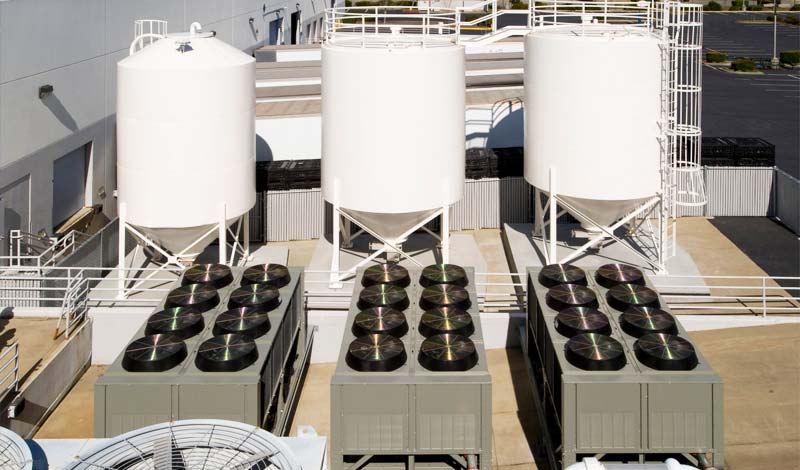In the United States, space conditioning, water heating and refrigeration represent approximately 50% of building energy demand, which is projected to increase in the future.
Though not widely used, thermal energy storage (TES) has emerged as a solution to lowering these energy costs and enhancing grid reliability. Commercially available technologies are based on ice storage and chilled water. Ice storage systems make ice during evening hours, when electricity costs about half that during the day. During the day on peak hours, a glycol solution circulates through the tanks and delivers the stored energy to the building to offset electric chiller cooling. The cold glycol is delivered at the proper temperature to the cooling coil in an air handler.
Advantages of ice storage include:
- Lower cooling bills by up to 40%
- Reduce or eliminate peak usage periods
- Avoid demand charges, typically 20% to 80% of monthly energy costs
- Store surplus renewable energy to balance the grid during peak demand
A 22-story, 270,000-square-foot commercial building in Philadelphia, Pennsylvania replaced its outdated 500- and 600-ton chillers with thermal energy storage tanks and two 300-ton chillers, along with upgraded controls and building automation systems. These upgrades save nearly $40,000 a month on energy costs during warmer months.
Ice storage generates an additional $10,000 of revenue per year by responding to demand response programs. Payback was only two years. APS rebates are available for both HVAC and Refrigeration (including PCM) thermal storage.
Not just for cooling
Ice storage is currently limited to cooling applications in large buildings with central chiller plants. To achieve 100% electrification, TES solutions are also needed for heating. This is where phase change materials (PCMs) come in. These materials absorb and release energy when transitioning between phases, such as from liquid to solid and back.
In buildings, PCMs could be added to walls or connected to a building’s heat pump or traditional HVAC system. When the ambient temperature rises above the material’s melting point, the phase change absorbs heat, cooling the building. When the temperature drops below the melting point, the phase change releases heat.
Conventional PCMs typically only work in one temperature range. Thus, two different materials would be needed for summer and winter, increasing costs. Researchers at Lawrence Berkeley National Laboratory (LBNL) have developed a potential solution: they have achieved a PCM where the transition (melting) temperature can be adjusted as needed.
Dynamic tunability allows the combination of thermal and electric energy into one device, thus storing and supplying both heat and electricity. This capability also increases the thermal storage potential. The costs of storage are reduced because the same material can be used for the entire year.
A cost of storage analysis showed that in many situations, TES can be more cost-effective for buildings than Li-ion batteries. Depending on the climate, optimized PCMs in U.S. building walls can provide reduction in the annual heat gain in the range of 3.5%–47.2% and the annual heat loss in the range of −2.8%–8.3%. More research is needed to increase the reduction in heat losses.
The LBNL team also has developed a prototype HVAC system for small commercial buildings that employed both cold and hot thermal batteries based on phase-change materials.
Expanding applications
Thermal energy storage can be used for district heating and cooling, in the transportation of chilled or frozen products and in solar power generation, where molten-salt technology is already deployed. Hybrid installations are being considered for power plants to manage large variations in demand. Standalone installations on the grid could enable load shifting.
